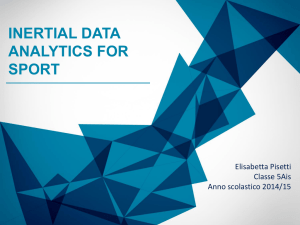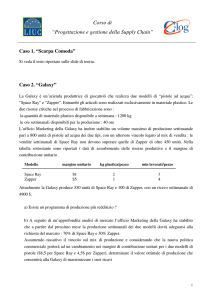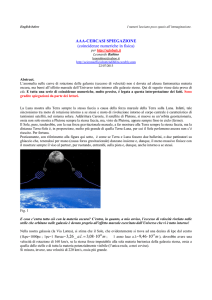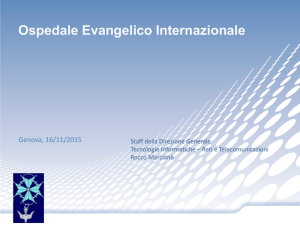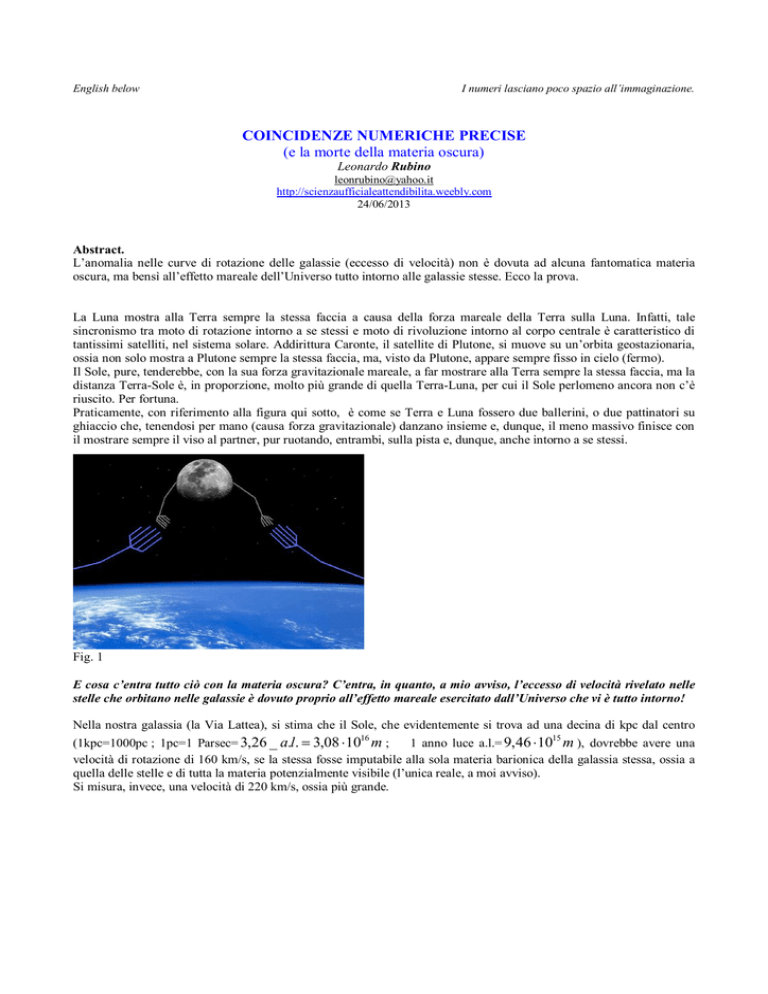
English below
I numeri lasciano poco spazio all’immaginazione.
COINCIDENZE NUMERICHE PRECISE
(e la morte della materia oscura)
Leonardo Rubino
[email protected]
http://scienzaufficialeattendibilita.weebly.com
24/06/2013
Abstract.
L’anomalia nelle curve di rotazione delle galassie (eccesso di velocità) non è dovuta ad alcuna fantomatica materia
oscura, ma bensì all’effetto mareale dell’Universo tutto intorno alle galassie stesse. Ecco la prova.
La Luna mostra alla Terra sempre la stessa faccia a causa della forza mareale della Terra sulla Luna. Infatti, tale
sincronismo tra moto di rotazione intorno a se stessi e moto di rivoluzione intorno al corpo centrale è caratteristico di
tantissimi satelliti, nel sistema solare. Addirittura Caronte, il satellite di Plutone, si muove su un’orbita geostazionaria,
ossia non solo mostra a Plutone sempre la stessa faccia, ma, visto da Plutone, appare sempre fisso in cielo (fermo).
Il Sole, pure, tenderebbe, con la sua forza gravitazionale mareale, a far mostrare alla Terra sempre la stessa faccia, ma la
distanza Terra-Sole è, in proporzione, molto più grande di quella Terra-Luna, per cui il Sole perlomeno ancora non c’è
riuscito. Per fortuna.
Praticamente, con riferimento alla figura qui sotto, è come se Terra e Luna fossero due ballerini, o due pattinatori su
ghiaccio che, tenendosi per mano (causa forza gravitazionale) danzano insieme e, dunque, il meno massivo finisce con
il mostrare sempre il viso al partner, pur ruotando, entrambi, sulla pista e, dunque, anche intorno a se stessi.
Fig. 1
E cosa c’entra tutto ciò con la materia oscura? C’entra, in quanto, a mio avviso, l’eccesso di velocità rivelato nelle
stelle che orbitano nelle galassie è dovuto proprio all’effetto mareale esercitato dall’Universo che vi è tutto intorno!
Nella nostra galassia (la Via Lattea), si stima che il Sole, che evidentemente si trova ad una decina di kpc dal centro
(1kpc=1000pc ; 1pc=1 Parsec= 3,26 _ a.l. = 3,08 ⋅ 10 m ;
1 anno luce a.l.= 9, 46 ⋅ 10 m ), dovrebbe avere una
velocità di rotazione di 160 km/s, se la stessa fosse imputabile alla sola materia barionica della galassia stessa, ossia a
quella delle stelle e di tutta la materia potenzialmente visibile (l’unica reale, a moi avviso).
Si misura, invece, una velocità di 220 km/s, ossia più grande.
16
15
Fig. 2 : Curva di rotazione delle stelle nella Via Lattea.
La scelta della scienza ufficiale (che, tra parentesi, è la stessa degli imbarazzanti neutrini superluminali,
dell’iperfinanziato bosone divino, dell’etere cosmico, dell’energia oscura ecc) è stata quella di supporre che tale
discrepanza sia dovuta all’esistenza di materia invisibile tutta intorno alle galassie; e mica poca. Spropositatamente di
più di quella visibile; pensa te. E tale materia, dicono loro, è appunto invisibile, in quanto non irradia fotoni; però,
evidentemente, è trasparente, in quanto, essendo tutta intorno alla galassia, non dovrebbe permetterci di vedere la
galassia stessa con i telescopi; ma noi le galassie le vediamo piuttosto bene….Mah, lasciamo perdere….
E, tra parentesi, indovina un po’ chi andrà ad occuparsi, ora, della fantomatica materia oscura? La stessa gente (e stessi
ambienti) del bosone divino e dei neutrini più veloci della luce….
Ma, con riferimento al diagramma qui sopra riportato, facciamo un attimo due conti della serva, giusto sugli ordini di
grandezza.
Il mio Universo è in contrazione con accelerazione cosmica aUniv = 7,62 ⋅ 10
seguente link : http://www.altrogiornale.org/request.php?42 )
−12
m s 2 (vedere la pagina 51 al
Ora, sappiamo tutti che un oggetto che cade da un’altezza h, sottoposto all’accelerazione di gravità ( g = 9,81 m s ),
giungerà al suolo con una velocità finale vf :
2
v f = 2 gh ;
Ciò ce lo insegna Newton. Bene; nel caso del Sole, l’accelerazione cosmica dell’Universo, efficace solo a grandi
distanze (grandi R, in quanto tale accelerazione è piccola; da cui l’anomalia delle velocità prevalentemente alla periferia
delle galassie………..) determina una Δv, di suo, della seguente entità:
( RGal ≅ 8,5kpc = 27,71 ⋅ 10 _ a.l. = 2,62 ⋅ 10 m è approssimativamente la distanza del Sole dal centro della Via
Lattea)
3
20
∆v = 2aUniv RGal = 2 ⋅ 7,62 ⋅ 10 −12 ⋅ 2,62 ⋅ 1020 = 63,2 ⋅ 103 m / s = 63,2km / s ,
(1)
che sono proprio quei 220-160=60km/s di Δv di discrepanza, nel grafico qui di sopra riportato (Fig. 2)!
E l’esattezza della formula vale su tutta la curva; ad esempio, a 25kpc, si ha un Δv=100km/s!
Ma trattasi, ripeto, di conti fatti a spanne! Come stanno di preciso le cose lo sa solo il Creatore. Non di certo i signori
della fantomatica materia oscura.
Fig. 3 : Curva di rotazione delle stelle nella galassia M33.
Anche osservando la curva di rotazione di un’altra galassia, ad esempio della M33, qui sopra, si vede che la mia
formula, la (1), funziona molto molto bene. Ma non è ciò che mi interessa; ciò che mi importa è che l’ordine di
grandezza dalla forza mareale dell’Universo circostante è proprio lo stesso della forza misteriosa che imprime alle stelle
una maggior velocità, nelle galassie. E, ovviamente, questo importante fatto non può che essere ignorato (termine
calzantissimo) dai sostenitori della materia oscura, ben consci del fatto che il prevalere della mia fisica comporterebbe
la morte immediata della loro (della loro fisica, se di fisica si può parlare…).
In ogni caso, pare che la distanza dal centro della galassia e il delta di velocità riscontrati dagli astrofisici siano uno
proporzionale alla radice dell’altra; e la radice è l’operazione inversa dell’elevazione al quadrato, tipica della legge di
Newton!
∆v ∝ kRGal
∆v
Fig. 4.
RGal
con k = 2aUniv
Dalle figure 2 e 3 si evince, facendo, per ogni punto delle curve, il rapporto tra ( ∆v ) ed RGal , che:
2
(∆v) 2 / RGal = 2aUniv = k = 2 ⋅ 7,62 ⋅ 10 −12 = 15,24 ⋅ 10−12 m s 2
−12
Ma chi è questa benedetta accelerazione aUniv = 7,62 ⋅ 10 m s ?
E’ l’accelerazione cosmica. Essendo appena scaturita dalle curve di rotazione delle galassie, denominiamola
accelerazione delta galaxy:
2
a∆Galaxy = aUniv = 7,62 ⋅ 10 −12 m s 2
(2)
Vediamo se essa è un numero familiare a tutto l’Universo e a tutta la fisica e non solo alle galassie.
Gli ammassi di galassie e l’accelerazione delta galaxy:
Fig. 5: Ammasso di galassie della Chioma.
La Fig. 5, qui sopra, è una foto dell’ammasso di galassie della Chioma, sul quale sono disponibili centinaia di
misurazioni; bene, sappiamo che tale ammasso dista da noi:
Δx=100 Mpc = 3,26 108 a.l. = 3,09 1024 m
e si allontana da noi ad una velocità:
Δv=6870 km/s=6,87 106 m/s.
Poi, dalla fisica, sappiamo che, banalmente:
∆x =
1
1
1
2 ⋅ ∆x
a ⋅ ∆t 2 = (a ⋅ ∆t ) ⋅ ∆t = ∆v ⋅ ∆t , da cui: ∆t =
, che usata nella definizione di accelerazione
2
2
2
∆v
aUniv , ci dà:
aUniv =
∆v
∆v
(∆v) 2
=
=
= aUniv ≅ 7,62 ⋅ 10−12 m / s 2 = a∆Galaxy ,
∆t 2 ⋅ ∆x 2 ⋅ ∆x
∆v
avendo utilizzato appunto i dati dell’ammasso della Chioma.
E’ questa l’accelerazione con cui perlomeno tutto il nostro Universo visibile accelera verso il centro di massa
dell’Universo intero. Ed è proprio l’accelerazione delta galaxy della (2).
L’elettrone e l’accelerazione delta galaxy:
Il raggio classico dell’elettrone si ottiene notoriamente eguagliando l’energia elettrostatica a quella intrinseca
dell’elettrone stesso ( me ⋅ c ):
2
1 e2
, da cui:
me ⋅ c =
4πε 0 re
2
1
e2
re =
≅ 2,8179 ⋅ 10−15 m .
2
4πε 0 me ⋅ c
Ora, sempre in senso classico, se immagino di calcolare l’accelerazione di gravità su un elettrone, come se lo stesso
fosse un piccolo pianetino, devo scrivere banalmente che:
mx ⋅ g e = G
ge = G
m x ⋅ me
, da cui:
re2
3 4
me
2 2 Gme c
=
8
π
ε
(= aUniv ) = 7,62 ⋅10 −12 m s 2 = a∆Galaxy
0
re2
e4
Uhm…, ottengo la stessa accelerazione sia per il tipo di oggetto cosmico più grande che conosco, ossia un ammasso di
galassie, che per un piccolissimo elettrone. E trattasi sempre dell’accelerazione delta galaxy della (2)! Munitevi di
calcolatrice e fate il conto nell’equazione qui sopra, se non ci credete!
Voglio vederci chiaro.
La Costante di Stefan-Boltzmann e l’accelerazione delta galaxy:
Premesse:
-si sa, dalla fisica, che a =
a∆Galaxy = aUniv =
RUniv =
c2
a ∆ Galaxy
v2
, da cui:
r
c2
= 7,62 ⋅ 10−12 m s 2 e quindi:
RUniv
= 1,17908 ⋅ 10 28 m
-sappiamo poi dalla Legge della Gravitazione Universale di Newton, che a = G ⋅ M / r , da cui:
2
2
a∆Galaxy = aUniv = G ⋅ M Univ / RUniv
= 7,62 ⋅ 10−12 m s 2 , e quindi:
M Univ =
2
a∆Galaxy RUniv
G
= 1,59486 ⋅ 1055 kg
-e, per ultimo, sappiamo dalla fisica, che il periodo è dato dalla circonferenza fratto la velocità:
2πRUniv
2πc
= 2,47118 ⋅ 1020 s , inoltre, per quanto sopra:
TUniv =
= 2,47118 ⋅ 1020 s
c
a∆Galaxy
con M Univ , RUniv e TUniv appena scaturiti dall’accelerazione delta galaxy a∆Galaxy !
TUniv =
Ricordiamo ora la Legge di Stefan-Boltzmann:
P[W ]
= σT 4 [W/m2] , dove σ = 5,67 ⋅10 −8W / m 2 K 4 è la
4πR 2
costante di Stefan-Boltzmann.
Ricordiamo poi la temperatura della radiazione cosmica di fondo CMBR: TCMBR ≅ 2,73K .
Ora, Einstein ci insegna che: EUniv = M Univc
2
e sappiamo dalla fisica che la potenza è: PUniv = EUniv TUniv = M Univc
2
TUniv , da cui:
M Univc 2
P[W ]
TUniv
σ=
=
= 5,67 ⋅ 10−8W / m 2 K 4
2 4
2
4
4πR T
4πRUniv
TCMBR
che è proprio appunto la costante di Stefan-Boltzmann! Eh, no… Adesso basta!
(Munitevi di calcolatrice e fate il conto nell’equazione qui sopra, se non ci credete!)
La velocità della luce e l’accelerazione delta galaxy:
Sappiamo che la luce, perlomeno nella zona di Universo dove ci troviamo noi ora, vale c=299.792,458 km/s.
Ora, casualmente, ci accorgiamo che:
c2 =
GM Univ
,
RUniv
c=
GM Univ
= RUniv a∆Galaxy = 299.792.458 m/s
RUniv
da cui:
Mah, sarà una coincidenza.
La Costante di Struttura Fine e l’accelerazione delta galaxy:
1 2
e
4πε 0
1
=
è la costante di struttura fine.
Sappiamo che la quantità α =
h
137
c
2π
Notiamo però che la Costante di Struttura Fine può essere espressa anche dalla seguente equazione:
Gme2
Gme2
1
2πGme2 c
r
r
α=
,
= e = e =
137 hν Univ h 1
hre a∆Galaxy
TUniv
dove TUniv =
2πc
a∆Galaxy
= 2,47118 ⋅ 1020 s
è il periodo dell’Universo che prima ricavammo in funzione
dell’accelerazione delta galaxy.
me ed re sono massa e raggio classico dell’elettrone: me = 9,1 ⋅ 10
…altra coincidenza…e per nulla grossolana…E’ molto precisa!…
−31
kg ed re = 2,818 ⋅ 10−15 m .
La Costante di Planck e l’accelerazione delta galaxy:
Mi accorgo che:
h=
a∆Galaxy mec
= 6,625 ⋅ 10− 34
π
[W] (coincidenza solo numerica, non dimensionale)
Mah, sarà, ancora una volta, un’altra coincidenza.
Ancora sulla Costante di Stefan-Boltzmann:
Mi accorgo che:
Te = TCMBR
1
h 1
= ( 2 2 ) 4 ≅ 2,73K !
4πre σ
Numero di elettroni (e positroni) potenziale, nell’Universo:
Beh, sappiamo che la massa dell’elettrone (particella “base” e stabile, nel nostro Universo; una vera armonica) è
me = 9,1 ⋅ 10−31 kg .
Per il numero potenziale di elettroni e positroni, banalmente, si ha:
N=
M Univ
≅ 1,75 ⋅ 1085
me
Dal momento, però, che il raggio classico dell’elettrone è re = 2,8179 ⋅ 10
−15
m , ci accorgiamo subito che:
RUniv = N re = 1,17908 ⋅ 10 m
28
Mah, sarà un’altra coincidenza.
Massa e raggio dell’elettrone:
Non so come mai (per ora), ma mi accorgo di due fatti strani:
me =
a∆Galaxy 2
re = 9,1 ⋅ 10 −31 kg
G
(proprio la massa dell’elettrone)
1
re = (
RUniv e 2
1
) 3 ≅ 2,8179 ⋅ 10−15 m
⋅
4πε 0 a∆Galaxy M Univ
(proprio il raggio classico dell’elettrone)
Mah, sarà, ancora una volta, un’altra coincidenza.
La densità osservata dell’Universo:
Notiamo che la densità dell’Universo calcolata tramite i numeri M Univ , RUniv (e TUniv ), appena scaturiti dalla
accelerazione delta galaxy a∆Galaxy , è proprio quella osservata dagli astrofisici:
4
3
) = 2.32273 ⋅10 − 30 kg / m3
ρ = M Univ /( π ⋅ RUniv
3
che non coincide, però, con quella teorica della cosmologia classica, supposto che la stessa ne abbia una, visto che
contemplano quantità spropositate di materia oscura, che però non si trova…
E si potrebbe continuare ancora…….
Costante di Boltzmann: k =
1
TCMBR
⋅
1
c7
15
⋅ ( me3 M Univ ) 4 = 1,38 ⋅ 10−23 J / K .
5 3
π RUniv 16
--------------------------------------
Per chi fosse interessato a capire cosa c’è dietro tutte queste apparenti coincidenze, è suggerita la lettura di quanto
riportato al link http://vixra.org/pdf/1305.0176v1.pdf , sul mio Universo oscillante.
Altre stranezze scientifiche della nostra era:
La particella di Dio che hanno cercato con poderosi mezzi, dicono, dovrebbe conferire la massa alle altre particelle. A
parte il fatto che, già nell’intuizione, non è ben chiaro come farebbe, plausibilmente, a conferire massa ad altri, ma
supposto che tutto ciò sia vero, ci saremmo sbarazzati di una piccola curiosità (l’origine della massa delle particelle) e
ce ne saremmo procurati un’altra gigantesca, ossia il capire perché tale conferimento succede e perché tale conferimento
esista. Diciamo che, in linea con il Rasoio di Occam, il bosone di Higgs è diretto (a mio avviso) verso una
complicazione del quadro della comprensione dell’Universo, e non verso una semplificazione.
Allora, per il Bosone Divino, Premio Nobel per la Fisica o per la Chimica?
No, perchè con l'aumentare delle energie in gioco e della poderosità degli acceleratori, di particelle se ne troveranno
ancora, esattamente come i chimici, che quasi ogni giorno, inventano vari nuovi composti organici, che sono ormai
milioni. Ma da qui a dire che tali nuove "creazioni" conferiscano massa ad altri (!!!) e abbiano a che fare con gli albori
dell'Universo è come dire che nell'Universo l'idrogeno si è formato a partire dalla decomposizione dell'uranio.
Semmai è il contrario. D'altro canto, certe lagrangiane chilometriche, con la plausibilità e con la semplicità
dell'Universo primordiale, poco hanno a che fare.
Povero Occam!
E già da svariati anni prima che A. Einstein esordì con la sua Teoria della Relatività Ristretta, un po’ tutte le Università
del mondo cercavano l’etere cosmico, in quanto si pensava che le onde elettromagnetiche, e dunque anche la luce,
dovessero necessariamente propagarsi in un mezzo, così come avviene per le onde sonore nell’aria. Si suppose dunque
che lo spazio fosse permeato da un gas invisibile e leggerissimo, detto appunto etere.
E tali Università fornivano addirittura valori molto accurati del valore della densità di tale etere!
L’esperimento di Michelson e Morley, volto a dimostrare il moto della Terra nell’etere, fu deludente in tal senso.
La questione venne risolta nel 1905 da un impiegato di terzo livello dell’Ufficio Brevetti di Berna, un certo Albert
Einstein, che suggerì di cessare di cercare di dimostrare il moto della Terra nell’etere, per il semplice fatto che l’etere
non esiste!
Aggiungo io che la materia oscura dei giorni nostri, bizzarra, pesante, trasparente e non plausibile, presto farà la stessa
fine!
Ma la storia parla chiaro; soprattutto quella contemporanea. Dopo:
-la morte dell'etere, nel 1905, per mano di un non addetto ai lavori, ossia un impiegato di terza classe dell'Ufficio
Brevetti di Berna
-la morte degli imbarazzanti neutrini tachionici
http://www.corriere.it/notizie-ultima-ora/Scienza_e_salute/Rubbia-neutrini-non-sono-piu-veloci-luce/16-03-2012/1-A_001292252.shtml
http://www.fisicamente.net/FISICA_2/Relativita_Ristretta_Rubino.pdf
http://www.fisicamente.net/FISICA_2/1785_RELATIVITA.pdf
-la morte della materia oscura
http://vixra.org/pdf/1306.0132v1.pdf
http://www.eso.org/public/italy/news/eso1217/
http://www.astronomia.com/2012/05/07/povera-materia-oscura-si-sta-rischiarando/
http://www.altrogiornale.org/comment.php?comment.news.7293
http://www.altrogiornale.org/news.php?item.7662.8
-la morte dell'energia oscura (che dovrebbe giustificare l’espansione accelerata del loro Universo)
http://rinabrundu.files.wordpress.com/2013/03/ovvieta-imbarazzanti-luniverso-in-contrazione.pdf
http://rinabrundu.files.wordpress.com/2012/06/lavvocato-hubble-e-la-presunta-espansione-delluniverso.pdf
http://www.cartesio-episteme.net/ep8/universo-che-verra.pdf
-la morte dell’attendibilità scientifica
http://www.altrogiornale.org/request.php?36
il silenzio, che già è calato, sancirà:
-LA MORTE DEL BOSONE DIVINO
http://rinabrundu.files.wordpress.com/2012/11/anything-but-superluminal-neutrinos-and-divine-bosons-by-leonardo-rubino.pdf
Grazie per l’attenzione.
Leonardo RUBINO
[email protected]
Appendice: Costanti fisiche.
Costante di Boltzmann k: 1,38 ⋅ 10
−23
J/K
−12
2
Accelerazione Cosmica aUniv: 7,62 ⋅ 10 m / s
11
Distanza Terra-Sole AU: 1, 496 ⋅ 10 m
24
Massa della Terra MTerra: 5,96 ⋅ 10 kg
6
Raggio della Terra RTerra: 6,371 ⋅ 10 m
−19
Carica dell’elettrone e: − 1,6 ⋅ 10 C
Numero di elettroni equivalente dell’Universo N: 1,75 ⋅ 10
85
Raggio classico dell’elettrone re: 2,818 ⋅ 10
Massa dell’elettrone me: 9,1 ⋅ 10
−15
m
−31
kg
−3
Costante di Struttura Fine α (≅ 1 137) : 7,30 ⋅ 10
−21
Frequenza dell’Universo ν 0 : 4,05 ⋅ 10 Hz
Pulsazione dell’Universo ω0 : 2,54 ⋅ 10
−20
rad s
Costante di Gravitazione Universale G: 6,67 ⋅ 10
−11
Nm 2 / kg 2
Periodo dell’Universo TUniv : 2,47 ⋅ 10 s
20
Anno luce a.l.: 9, 46 ⋅ 10 m
15
Parsec pc: 3,26 _ a.l. = 3,08 ⋅ 10 m
16
Densità dell’Universo ρUniv: 2,32 ⋅ 10
−30
kg / m3
Temp. della Radiaz. Cosmica di Fondo T: 2,73K
−6
Permeabilità magnetica del vuoto μ0: 1, 26 ⋅ 10 H / m
−12
Permittività elettrica del vuoto ε0: 8,85 ⋅ 10 F / m
−34
Costante di Planck h: 6,625 ⋅ 10 J ⋅ s
−27
Massa del protone mp: 1,67 ⋅ 10 kg
30
Massa del Sole MSun: 1,989 ⋅ 10 kg
8
Raggio del Sole RSun: 6,96 ⋅ 10 m
8
Velocità della luce nel vuoto c: 2,99792458 ⋅ 10 m / s
−8
2 4
Costante di Stefan-Boltzmann σ: 5,67 ⋅ 10 W / m K
28
Raggio dell’Universo (dal centro fino a noi) RUniv: 1,18 ⋅ 10 m
55
Massa dell’Universo (entro RUniv) MUniv: 1,59 ⋅ 10 kg
Numbers leave very little to imagination.
SHARP NUMERICAL COINCIDENCES
(and the death of dark matter)
Leonardo Rubino
[email protected]
http://scienzaufficialeattendibilita.weebly.com
24/06/2013
Abstract.
The anomaly in the rotation curves for galaxies (excess of speed) is not due to any mysterious dark matter, but rather to
the tidal effect of the Universe all around the galaxies themselves. Here is the proof.
The Moon always shows the same side to the Earth, because of the tidal force of the Earth on the Moon itself. As a
matter of fact, such a syncronism between motion around oneselves and revolution motion around a central body is
typical for many satellites, in the solar system. Even Charon, which is the satellite of Pluto, moves on a geostationary
orbit, so not only by showing the same side to Pluto, but, if seen from Pluto itself, looks still in the sky.
The Sun, also, would tend to make the Earth show the same side, by its tidal gravitational force, but the distance EarthSun is proportionally much larger than that Earth-Moon, so the Sun (fortunately) hasn’t been able to do that, yet.
In practice, with reference to the image below, it’s like if the Earth and the Moon were two dancers, or two ice skaters
who, holding each other by hand (due to the gravitational pull) dance together, and so the less massive ends up in
showing always the face to his partner, although they both rotate, on the dance floor (or on the rink), and so also around
themselves.
Fig. 1.
And what does all this have to do with the dark matter? A lot, as, in my opinion, the extra speed measured on stars
spinning around galaxies is really due to the tidal effect exerted by the Universe which is all around!
In our galaxy (the Milky Way), the Sun, being at something like ten kpc from the center, (1kpc=1000pc ; 1pc=1
Parsec= 3,26 _ l. y. = 3,08 ⋅ 10 m ; 1 light year l.y.= 9, 46 ⋅ 10 m ), should have a rotation speed of 160 km/s, if it
were due to the mere baryonic matter of the galaxy itself, i.e. that of the stars and of all the potentially visible matter
(the only one which is real, in my opinion).
16
On the contrary, they measure a speed of 220 km/s, i.e. bigger.
15
Fig. 2: Rotation curve of the stars in the Milky Way.
The choice of the official science (which is, besides, the same of the embarrassing superluminal neutrinos, of the
ultrafunded divine boson, of the cosmic ether, of the dark energy etc) has been that of supposing such a discrepancy is
due to the existence of invisible matter all around galaxies; and not so little. Enormously more than that visible;
unbelievable. And such a matter, they say, is invisible, indeed, as it’s not emitting photons; but it must be transparent, as
it is all around the galaxy, so preventing us from seeing the galaxy by telescopes; but we can see galaxies very
well…Uhm, never mind…
And, by the way, who is going to take care of the mysterious dark matter now? The same people (the same
environments) of the divine boson and of the neutrinos faster than light….
But, with reference to the graph above reported (Fig. 2), let’s carry out some rough calculations, just to evaluate the size
of the problem.
−12
My Universe is collapsing by a cosmic acceleration aUniv = 7,62 ⋅ 10 m s (see page 12 at the following link :
http://www.altrogiornale.org/request.php?42 )
Now, we all know that an object which falls from a height h, as is undergoing the gravitational acceleration
2
( g = 9,81 m s ), will reach the ground with the final speed vf :
2
v f = 2 gh ;
Newton taught us all that. Well then; for the Sun, the cosmic acceleration of the Universe, important only at great
distances (great R, as such an acceleration is small; from which comes the anomaly of the speeds mostly at the outer
side of the galaxies……..) determines a Δv, of itself, as big as follows:
( RGal ≅ 8,5kpc = 27,71 ⋅ 10 _ l. y. = 2,62 ⋅ 10 m is roughly the distance of the Sun from the centre of the Milky
Way)
3
20
∆v = 2aUniv RGal = 2 ⋅ 7,62 ⋅ 10 −12 ⋅ 2,62 ⋅ 1020 = 63,2 ⋅ 103 m / s = 63,2km / s ,
(1)
which are really those 220-160=60km/s of Δv of discrepancy, in the graph above reported (Fig. 2)!
And the exactness of such a formula holds on all the curve; for instance, at 25kpc, you have a Δv=100km/s!
But, I repeat, all this is about rough calculations! Only God knows exactly as things work. For sure, not the gentlemen
(and ladies) of the mysterious dark matter.
Fig. 3: Rotation curve of stars in galaxy M33.
Also about the rotation curve of another galaxy, for instance the M33, above reported, we can see my formula, (1),
works very well. But this is not the main thing I’m interested in. What I care is that the size of the tidal force of the
Universe all around is really the same as that of the mysterious force which gives the stars a higher speed, in galaxies.
And, of course, this important fac twill be surely ignored (very right word) from the supporters of the dark matter, who
well know that the prevailing of my physics will imply the death of theirs (of their physics, if it’s about « physics »…).
Anyway, it seems the distance from the centre of the galaxy and the delta speeds measured by astrophysicists are one
proportional to the square root of the other; and the square root is is the opposite operation of the power two, which is
typical for the Newton’s law.
∆v ∝ kRGal
∆v
RGal
Fig. 4.
where k = 2aUniv
From figures 2 and 3 we can see, by calculating, for each point of the curves, the ratio ( ∆v ) - RGal
2
(∆v) / RGal = 2aUniv = k = 2 ⋅ 7,62 ⋅ 10
2
−12
= 15,24 ⋅ 10
−12
−12
m s
, that:
2
But who the hell is such an acceleration aUniv = 7,62 ⋅ 10 m s ?
It’s the cosmic acceleration. As it has just come out from the rotation curves of galaxies, let’s call it delta galaxy
acceleration:
2
a∆Galaxy = aUniv = 7,62 ⋅ 10 −12 m s 2
(2)
Let’s see if it’s a number familiar to all the rest of the Universe and to all the physics, and not only to galaxies.
The galaxy clusters and the delta galaxy acceleration :
Fig. 5: Coma galaxy cluster.
Fig. 5 is a picture of the Coma galaxy cluster; hundreds of measurements on it are available; well, we know that its
distance from us is:
Δx=100 Mpc = 3,26 108 l.y. = 3,09 1024 m
and it gets farther from us with a speed:
Δv=6870 km/s=6,87 106 m/s.
Then, from physics we know that:
∆x =
1
1
1
2 ⋅ ∆x
a ⋅ ∆t 2 = (a ⋅ ∆t ) ⋅ ∆t = ∆v ⋅ ∆t , from which: ∆t =
, which can be used in the definition of
2
2
2
∆v
acceleration aUniv , so giving:
aUniv =
∆v
∆v
(∆v) 2
=
=
= aUniv ≅ 7,62 ⋅ 10−12 m / s 2 = a∆Galaxy ,
2
⋅
∆
x
∆t
2 ⋅ ∆x
∆v
after that we used data on Coma galaxy cluster, indeed.
This is the acceleration by which all the visible Universe accelerates towards the centre of mass of the Universe itself.
And it’s really the delta galaxy acceleration in equation (2).
The electron and the delta galaxy acceleration:
The classic radius of the electron is defined by the equality of its energy E=mec2 and its electrostatic one, imagined on
its surface (in a classic sense):
me ⋅ c 2 =
re =
1 e2
, from which:
4πε 0 re
1
e2
≅ 2,8179 ⋅ 10−15 m .
2
4πε 0 me ⋅ c
Now, still in a classic sense, if we imagine, for instance, to figure out the gravitational acceleration on an electron, as if
it were a small planet, we must easily conclude that:
mx ⋅ g e = G
ge = G
m x ⋅ me
, from which:
re2
3 4
me
2 2 Gme c
=
8
π
ε
(= aUniv ) = 7,62 ⋅10 −12 m s 2 = a∆Galaxy
0
2
4
re
e
Uhm…, I get the same acceleration for the largest cosmic object I know, a galaxy cluster, as well as for a very little
electron. And it’s still about the delta galaxy acceleration in equation (2)! Get a calculator and check the equation above
reported, if you don’t trust me!
I want to go deeper in all this.
The Stefan-Boltzmann’s constant and the delta galaxy acceleration:
Preamble:
-we know from physics that a =
a∆Galaxy = aUniv =
RUniv =
c2
a ∆ Galaxy
v2
, from which:
r
c2
= 7,62 ⋅ 10−12 m s 2 and so:
RUniv
= 1,17908 ⋅ 10 28 m
-then, we know from the Newton’s Universal Gravitation Law, that a = G ⋅ M / r , from which:
2
2
a∆Galaxy = aUniv = G ⋅ M Univ / RUniv
= 7,62 ⋅ 10−12 m s 2 , and so:
M Univ =
2
a∆Galaxy RUniv
G
= 1,59486 ⋅ 1055 kg
-and, at last, we know from physics that the period is given by the ratio between circumference and speed:
2πc
2πRUniv
TUniv =
= 2,47118 ⋅ 1020 s
= 2,47118 ⋅ 1020 s ; moreover (see above):
c
a∆Galaxy
where M Univ , RUniv and TUniv are just come out from the delta galaxy acceleration a∆Galaxy !
TUniv =
Now, let’s introduce the Stefan-Boltzmann Law:
P[W ]
= σT 4 [W/m2] , where σ = 5,67 ⋅10 −8W / m 2 K 4 is the
2
4πR
Stefan-Boltzmann’s constant.
Moreover, we remind ourselves of the Cosmic Microwave Background Radiation CMBR temperature:
TCMBR ≅ 2,73K .
Now, Einstein says that: EUniv = M Univc
2
and we know from physics that the power is: PUniv = EUniv TUniv = M Univc
2
TUniv , from which:
2
M Univc
P[W ]
TUniv
σ=
=
= 5,67 ⋅ 10−8W / m 2 K 4
2 4
2
4
4πR T
4πRUnivTCMBR
which is exactly the Stefan-Boltzmann’s Constant! Oh, no… That’s enough!
(Get a calculator and check the equation above reported, if you don’t trust me!)
The speed of light and the delta galaxy acceleration:
We know that the speed of light, at least in the zone of the Universe where we live, is c=299.792,458 km/s.
Now, incidentally, we realize that:
c2 =
GM Univ
,
RUniv
c=
GM Univ
= RUniv a∆Galaxy = 299.792.458 m/s
RUniv
from which:
Uhm, it’s just a coincidence.
The Fine Structure Constant and the delta galaxy acceleration:
1 2
e
4πε 0
1
=
is the Fine Structure Constant.
We know that α =
h
137
c
2π
But we see that the Fine Structure Constant can be given also by the following equation:
Gme2
Gme2
1
2πGme2 c
r
r
α=
= e = e =
,
hre a∆Galaxy
137 hν Univ h 1
TUniv
where TUniv =
2πc
a∆Galaxy
= 2,47118 ⋅ 1020 s is the periodo f the Universe we calculated before, as a function of the
delta galaxy acceleration.
me and re are mass and classic radius of the electron: me = 9,1 ⋅ 10
…another coincidence…and not coarse at all…It’s very sharp!...
−31
kg and re = 2,818 ⋅ 10−15 m .
Planck’s Constant and the delta galaxy acceleration:
I realize that:
h=
a∆Galaxy mec
= 6,625 ⋅ 10− 34
π
[W] (coincidence just numerical, not dimensional)
Uhm, once again, a coincidence.
Still on Stefan-Boltzmann’s Constant:
I realize that:
Te = TCMBR
1
h 1
= ( 2 2 ) 4 ≅ 2,73K !
4πre σ
Potential number of electrons (and positrons) in the Universe:
Well, we know that the mass of the electron (“base” and stable particle, in the Universe; a real harmonic) is
me = 9,1 ⋅ 10−31 kg .
In order to get the potential number of electrons and positrons, we easily say:
N=
M Univ
≅ 1,75 ⋅ 1085
me
On the other hand, as the classic radius of the electron is: re = 2,8179 ⋅ 10
−15
m , we immediately realize that:
RUniv = N re = 1,17908 ⋅ 1028 m
Ops, it could be another coincidence…
Mass and radius of the electron:
I do not know why (for the moment), but I notice two strange questions:
me =
a∆Galaxy 2
re = 9,1 ⋅ 10 −31 kg
G
(the mass of the electron, indeed)
1
RUniv e 2
1
re = (
) 3 ≅ 2,8179 ⋅ 10−15 m
⋅
4πε 0 a∆Galaxy M Univ
(the classic radius of the electron, indeed)
Well, once again a coincidence…
The observed density of the Universe:
We notice that the density of the Universe which can be figured by numbers M Univ , RUniv (and TUniv ), just come out
from the delta galaxy acceleration a∆Galaxy , is really that observed by astrophysicists:
4
3
) = 2.32273 ⋅10 − 30 kg / m3
ρ = M Univ /( π ⋅ RUniv
3
and its not the same as that theoretical from classic cosmology, hoping that they have one, as they talk about bunches of
dark matter which cannot be found…
And we could go on and on…….
Boltzmann’s Constant: k =
1
TCMBR
⋅
1
c7
15
⋅ ( me3 M Univ ) 4 = 1,38 ⋅ 10−23 J / K .
5 3
π RUniv 16
For all those whom want to understand what’s behind all these apparent coincidences, I suggest the reading of what is
reported at the following link http://vixra.org/pdf/1305.0176v1.pdf , on my oscillating Universe.
Further scientific strangenesses in our time:
The particle of God they looked for by powerful means, should give mass to particles. Since the beginning, it’s not so
clear as it could plausibly give mass to other particles, but even if all what has been said on it is true, then we would
have got rid of a little mystery (the origins of the mass of particles), but we’d also have faced a new and bigger mystery,
that is the understanding why such a giving of mass occurs and exists. Let’s say that, according to the Occam’s razor,
Higgs’ boson will make the Universe more difficult to be understood, in my opinion, rather than easier.
And so, for such a Divine Boson, a Nobel Prize for the Physics or for the Chemistry?
In fact, such a question arises as by increasing energies and by using more powerful accelerators, they will find further
new particles, as well as chemists, almost every day, invent new organic compounds, that are millions, nowadays. But
all this is not the same as to say that such new “creations” give mass to others (!!!) and that have something to do with
the early Universe. On the contrary, all this is like to say that in the Universe the hydrogen comes from uranium.
At least, it’s exactly the opposite. On the other hand, some ultra long lagrangians have very little to do with the
plausibility and the simplicity of the early Universe.
Poor Occam!
And a lot of years before A. Einstein published his Theory of Relativity, all the Universities, all over the world, were
looking for the cosmic ether, as they thought the electromagnetic waves, and so also the light, should necessarily
propagate in a mean, as well as for the sounds in the air. So, they supposed the space was filled with an extremely light
and transparent gas, called ether, indeed.
And those Universities even gave very sharp values for the density of such an ether!
The Michelson and Morley experiment, made to prove the movement of the Earth through the ether, failed.
The question was solved in 1905 by an employee of the Patent Office in Berne, Albert Einstein, who suggested to cease
trying to prove the movement of the earth through the ether, as ether doesn’t simply exist!
I add that dark matter we talk about nowadays, so strange, heavy, transparent and not plausible, will soon end up like
ether!
But hystory talks plainly. The contemporary one, especially, does.
After:
-the death of the ether, in 1905, caused by an outsider, that is a third level technician of the Patent Office of Berne
-the death of the embarrassing superluminal neutrinos
http://www.corriere.it/notizie-ultima-ora/Scienza_e_salute/Rubbia-neutrini-non-sono-piu-veloci-luce/16-03-2012/1-A_001292252.shtml
http://www.fisicamente.net/FISICA_2/Relativita_Ristretta_Rubino.pdf
http://www.fisicamente.net/FISICA_2/1785_RELATIVITA.pdf
-the death of the dark matter
http://vixra.org/pdf/1306.0132v1.pdf
http://www.eso.org/public/italy/news/eso1217/
http://www.astronomia.com/2012/05/07/povera-materia-oscura-si-sta-rischiarando/
http://www.altrogiornale.org/comment.php?comment.news.7293
http://www.altrogiornale.org/news.php?item.7662.8
-the death of the dark energy (which should justify the accelerated expansion of their Universe)
http://rinabrundu.files.wordpress.com/2013/03/ovvieta-imbarazzanti-luniverso-in-contrazione.pdf
http://rinabrundu.files.wordpress.com/2012/06/lavvocato-hubble-e-la-presunta-espansione-delluniverso.pdf
http://www.cartesio-episteme.net/ep8/universo-che-verra.pdf
-the death of the science reliability
http://www.altrogiornale.org/request.php?36
the silence, already fallen down, will ratify:
-THE DEATH OF THE DIVINE BOSON
http://rinabrundu.files.wordpress.com/2012/11/anything-but-superluminal-neutrinos-and-divine-bosons-by-leonardo-rubino.pdf
Thank you for your attention.
Leonardo RUBINO
[email protected]
Appendix: Physical Constants.
Boltzmann’s Constant k: 1,38 ⋅ 10
−23
J/K
2
Cosmic Acceleration aUniv: 7,62 ⋅ 10 m / s
11
Distance Earth-Sun AU: 1, 496 ⋅ 10 m
24
Mass of the Earth MEarth: 5,96 ⋅ 10 kg
6
Radius of the Earth REarth: 6,371 ⋅ 10 m
−19
Charge of the electron e: − 1,6 ⋅ 10 C
−12
Number of electrons equivalent of the Universe N: 1,75 ⋅ 10
85
Classic radius of the electron re: 2,818 ⋅ 10
Mass of the electron me: 9,1 ⋅ 10
−31
−15
m
kg
Finestructure Constant α (≅ 1 137) : 7,30 ⋅ 10
Frequency of the Universe ν 0 : 4,05 ⋅ 10
Pulsation of the Universe ω0 : 2,54 ⋅ 10
−21
−20
−3
Hz
rad s
Universal Gravitational Constant G: 6,67 ⋅ 10
−11
Nm 2 / kg 2
Period of the Universe TUniv : 2,47 ⋅ 10 s
20
Light Year l.y.: 9, 46 ⋅ 10 m
15
Parsec pc: 3,26 _ a.l. = 3,08 ⋅ 10 m
16
Density of the Universe ρUniv: 2,32 ⋅ 10
−30
kg / m3
Microwave Cosmic Radiation Background Temp. T: 2,73K
−6
Magnetic Permeability of vacuum μ0: 1, 26 ⋅ 10 H / m
Electric Permittivity of vacuum ε0: 8,85 ⋅ 10
Planck’s Constant h: 6,625 ⋅ 10
−34
−12
F /m
J ⋅s
Mass of the proton mp: 1,67 ⋅ 10 kg
30
Mass of the Sun MSun: 1,989 ⋅ 10 kg
8
Radius of the Sun RSun: 6,96 ⋅ 10 m
8
Speed of light in vacuum c: 2,99792458 ⋅ 10 m / s
−8
2 4
Stefan-Boltzmann’s Constant σ: 5,67 ⋅ 10 W / m K
28
Radius of the Universe (from the centre to us) RUniv: 1,18 ⋅ 10 m
55
Mass of the Universe (within RUniv) MUniv: 1,59 ⋅ 10 kg
−27

